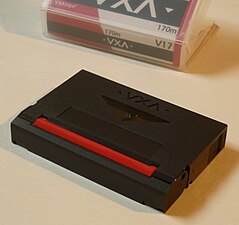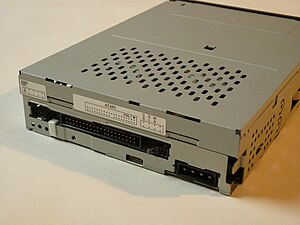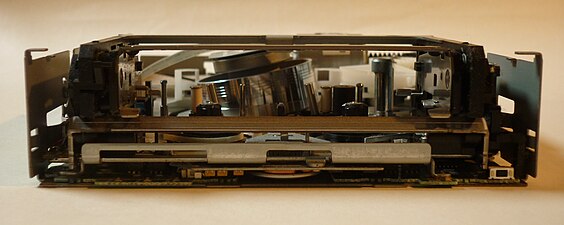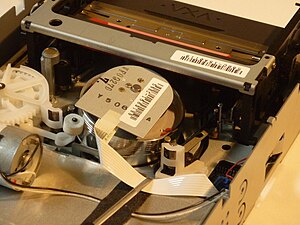
Digital Audio Tape is a signal recording and playback medium developed by Sony and introduced in 1987. In appearance it is similar to a Compact Cassette, using 3.81 mm / 0.15" magnetic tape enclosed in a protective shell, but is roughly half the size at 73 mm × 54 mm × 10.5 mm. The recording is digital rather than analog. DAT can record at sampling rates equal to, as well as higher and lower than a CD at 16 bits quantization. If a comparable digital source is copied without returning to the analogue domain, then the DAT will produce an exact clone, unlike other digital media such as Digital Compact Cassette or non-Hi-MD MiniDisc, both of which use a lossy data-reduction system.
Tandberg Data GmbH is a company focused on data storage products, especially streamers, headquartered in Dortmund, Germany. They are the only company still selling drives that use the QIC and VXA formats, but also produce LTO along with autoloaders, tape libraries, NAS devices, RDX Removable Disk Drives, Media and Virtual Tape Libraries.

Helical scan is a method of recording high-frequency signals on magnetic tape. It is used in open-reel video tape recorders, video cassette recorders, digital audio tape recorders, and some computer tape drives.

Digital Data Storage (DDS) is a computer data storage technology that is based upon the Digital Audio Tape (DAT) format that was developed during the 1980s. DDS is primarily intended for use as off-line storage, especially for generating backup copies of working data.

Digital Linear Tape (DLT; previously called CompacTape) is a magnetic-tape data storage technology developed by Digital Equipment Corporation (DEC) from 1984 onwards. In 1994, the technology was purchased by Quantum Corporation, who manufactured drives and licensed the technology and trademark. A variant with higher capacity is called Super DLT (SDLT). The lower cost "value line" was initially manufactured by Benchmark Storage Innovations under license from Quantum. Quantum acquired Benchmark in 2002.

Advanced Intelligent Tape (AIT) is a discontinued high-speed, high-capacity magnetic tape data storage format developed and controlled by Sony. It competed mainly against the DLT, LTO, DAT/DDS, and VXA formats. AIT uses a cassette similar to Video8. Super AIT (SAIT) is a higher capacity variant using wider tape in a larger, single-spool cartridge. Both AIT and SAIT use the helical scan method of reading and writing the tape.
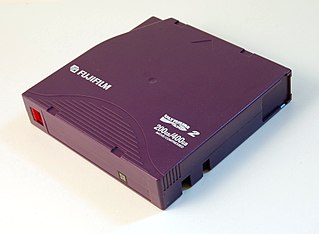
Linear Tape-Open (LTO) is a magnetic tape data storage technology originally developed in the late 1990s as an open standards alternative to the proprietary magnetic tape formats that were available at the time. Hewlett Packard Enterprise, IBM, and Quantum control the LTO Consortium, which directs development and manages licensing and certification of media and mechanism manufacturers.

Travan is an 8 mm magnetic tape cartridge design developed by the 3M company, used for the storage of data in computer backups and mass storage. Over time, subsequent versions of Travan cartridges and drives have been developed that provide greater data capacity, while retaining the standard 8 mm width and 750' length. Travan is standardized under the QIC body. HP Colorado, Iomega DittoMax and AIWA Bolt are proprietary versions of the Travan format.

The 8 mm backup format is a discontinued magnetic tape data storage format used in computer systems, pioneered by Exabyte Corporation. It is also known as Data8, often abbreviated to D8 and is written as D-Eight on some Sony branded media. Such systems can back up up to 60 GB of data depending on configuration. The cassettes have the same dimensions and construction as the cassettes used in 8 mm video format recorders and camcorders.
The IBM 3850 Mass Storage System (MSS) was an online tape library used to hold large amounts of infrequently accessed data. It was one of the earliest examples of nearline storage.
NT is a digital memo recording system introduced by Sony in 1992, sometimes marketed under the name Scoopman.

Exabyte Corporation was a manufacturer of magnetic tape data storage products headquartered in Boulder, Colorado, United States. Exabyte Corp. is now defunct, but the company's technology is sold by Tandberg Data under both brand names. Prior to the 2006 demise, Exabyte offered tape storage and automation solutions for servers, workstations, LANs and SANs. Exabyte is best known for introducing the Data8 (8 mm) magnetic tape format in 1987. At the time of its demise, Exabyte manufactured VXA and LTO based products. The company controlled VXA technology but did not play a large role in the LTO community.

Optical disc authoring requires a number of different optical disc recorder technologies working in tandem, from the optical disc media to the firmware to the control electronics of the optical disc drive.
Storage Technology Corporation created several magnetic tape data storage formats. These are commonly used with large computer systems, typically in conjunction with a robotic tape library. The most recent format is the T10000. StorageTek primarily competed with IBM in this market, and continued to do so after its acquisition by Sun Microsystems in 2005 and as part of the Sun Microsystems acquisition by Oracle in 2009.

Digital Tape Format is a magnetic tape data storage format developed by Sony. It uses a 1/2" wide tape, in a cassette with two reels, which is written and read with a helical scan process. The format is described by the ECMA 248 and ISO/IEC 15731 standards. There are two sizes of tape cassettes, "S" and "L".
Magnetic-tape data storage is a system for storing digital information on magnetic tape using digital recording.
RDX is a disk-based removable storage format developed by ProStor Systems Incorporated in 2004. In May 2011, Tandberg Data GmbH acquired the RDX business from ProStor Systems including intellectual property and key members of ProStor's RDX engineering team. RDX is intended as a replacement of tape storage. RDX removable disk technology consists of portable disk cartridges and an RDX dock. RDX cartridges are shock-proof 2.5-inch Serial ATA hard disk drives and are advertised to sustain a 1 meter (39 in) drop onto a concrete floor and to offer an archival lifetime up to 30 years and transfer up to 650GB/hr.
The Linear Tape File System (LTFS) is a file system that allows files stored on magnetic tape to be accessed in a similar fashion to those on disk or removable flash drives. It requires both a specific format of data on the tape media and software to provide a file system interface to the data.

